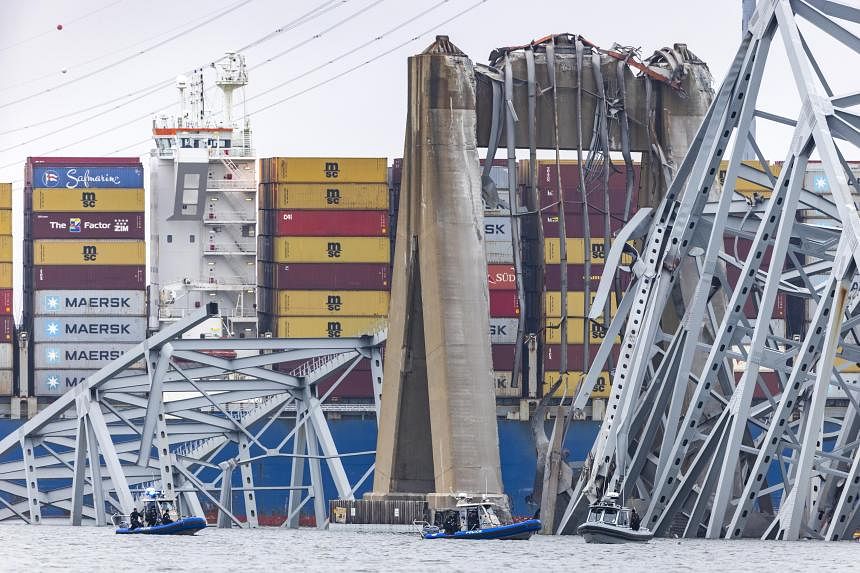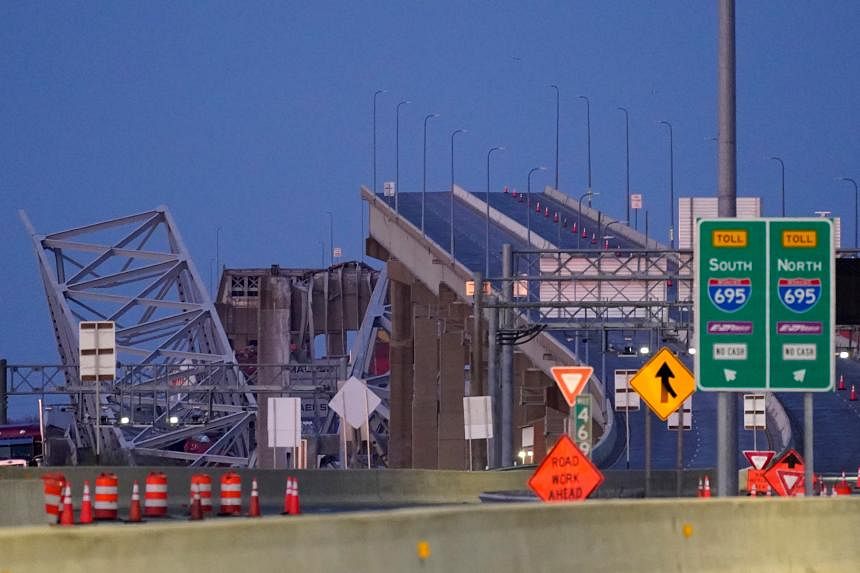BALTIMORE - The pilot of the cargo freighter that knocked down a highway bridge into Baltimore Harbour had radioed for tugboat help and reported a power loss minutes earlier, federal safety officials said on March 27, citing audio from the ship’s “black box” data recorder.
The head of the National Transportation Safety Board (NTSB) also said that Francis Scott Key Bridge, a traffic artery over the harbour which opened in 1977, lacked structural engineering redundancies common to newer spans, making it more vulnerable to a catastrophic collapse.
New insights into the fatal disaster emerged a day after the massive Singapore-flagged container ship Dali sailing out of Baltimore Harbour bound for Sri Lanka reported losing power and the ability to manoeuvre before ploughing into a support pylon of the bridge.
The impact brought most of the bridge tumbling into the mouth of the Patapsco River almost immediately, blocking shipping lanes and forcing the indefinite closure of the Port of Baltimore, one of the busiest on the US Eastern Seaboard.
Divers on March 27 recovered the remains of two of the six workers missing since the crumbling bridge tossed them into the water, officials said.
Maryland State Police’s Colonel Roland Butler said a red pickup truck containing the bodies of the two men was found in about 7.6m of water near the mid-section of the fallen bridge.
He also said the authorities had suspended efforts to locate and retrieve more bodies from the depths because of increasingly treacherous conditions in the wreckage-strewn river.
Col Butler said sonar images showed additional submerged vehicles “encased” in fallen bridge debris and superstructure, making them difficult to reach.
The two men whose bodies were recovered on March 27 were identified as Mr Alejandro Hernandez Fuentes, 35, of Baltimore, a native of Mexico, and Mr Dorlian Ronial Castillo Cabrera, 26, of nearby Dundalk, originally from Guatemala.
Four more workers who were part of a crew filling potholes on the bridge’s road surface remained missing and are presumed dead.
The six workers also included immigrants from Honduras and El Salvador, officials said.
Rescuers pulled two workers from the water alive on March 26, and one was hospitalised.
The economic fallout could be staggering.
The port handles more automobile and farm equipment freight than any other in the country, as well as container freight and bulk goods ranging from sugar to coal.
US Transportation Secretary Pete Buttigieg said 8,000 jobs are “directly associated” with port operations, which generate US$2 million (S$2.7 million) a day in wages.
Still, economists and logistics experts doubted the port closure would trigger a major US supply chain crisis or significant spike in the price of goods, due to ample capacity at rival shipping hubs along the East Coast.
Britannia, insurer of the Dali, is working with the vessel’s owner and the US authorities on the investigation.
The disaster is likely to result in industrywide multibillion-dollar insurance claims, which could make it the largest single marine insurance loss, Lloyd’s of London chairman Bruce Carnegie-Brown said on March 28.
Lloyd’s, which has over 50 member firms, is active in the marine and property insurance markets, which are expected to face large claims from the damage to the bridge and the port disruption.
The collapse, which occurred at 1.30am, has created a traffic quagmire as well for Baltimore and the surrounding region.
Interviewing survivors
Earlier on March 27, an NTSB team boarded the idled freighter, still anchored in the harbour channel with part of the mangled bridge splayed over its bow, to begin interviewing the ship’s two pilots and 21 regular crew members who remained on the vessel, said NTSB chief Jennifer Homendy.
Investigators also began reviewing information collected from the ship’s Voyage Data Recorder, including radio traffic between the pilot and shore-based authorities leading up to the disaster.
The pilot was heard calling for tugboat assistance several minutes before the crash, the first indication of distress to harbour officials, followed by a radio report that the ship had lost all power and was approaching the bridge, NTSB officials said at a news briefing on March 27.
Video footage that captured the accident show the ship’s lights winking off, then back on briefly before the vessel’s lights go out again.
Ms Homendy said recorder data was “consistent with a power outage” but that an actual blackout had yet to be confirmed.
The recorder also picked up commands to the crew to drop anchor, presumably aimed at slowing the vessel.
Safety board investigator Marcel Muise said data showed the Dali, measuring about three football fields in length and piled high with shipping containers, was moving at about 12.8kmh when it struck a bridge abutment.
Ms Homendy noted that the bridge, while deemed to be in “satisfactory” condition from its most recent inspection in 2023, was constructed in such a way that failure of one structural member “would likely cause a portion of or the entire bridge to collapse”.
Further details of last-minute efforts to save lives emerged on March 27 from open-source recordings of emergency radio chatter from the moments that the authorities were alerted that the cargo ship Dali was drifting out of control towards Key Bridge, as the structure is also known.
“Hold all traffic on the Key Bridge. There’s a ship approaching that just lost their steering,” someone is heard saying over a police radio.
While voices were heard discussing next steps, including alerting any work crews to leave the bridge, one broke through to say: “The whole bridge just fell down!”
The audio was carried by Broadcastify, an open-source audio streaming service.
The recording offered a glimpse of how the authorities scrambled before the crash.
Focus on opening port, cause of crash
The US Coast Guard’s priorities are to restore the waterway for shipping, stabilise the vessel and extricate it, Vice-Admiral Peter Gautier said at a White House news briefing.
Of the ship’s 4,700 cargo containers, 56 hold hazardous materials but there is no threat to the public, he said. Two containers went overboard during the crash, but they did not contain hazardous materials.
The ship was carrying more than 5.7 million litres of fuel oil, he added.
Ms Homendy said some of the hazmat containers aboard the vessel had been breached, and a sheen was noticed on the water’s surface. REUTERS




